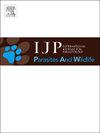Chasing intermediate hosts of Echinococcus multilocularis at the southern edge of its European distribution using red fox stomach content analysis
IF 2.2
3区 医学
Q3 ECOLOGY
International Journal for Parasitology-Parasites and Wildlife
Pub Date : 2025-06-02
DOI:10.1016/j.ijppaw.2025.101095
引用次数: 0
Abstract
Echinococcus multilocularis (Em) is a Taeniidae cestode circulating among canids (definitive hosts) and among voles (intermediate hosts). Humans can develop alveolar echinococcosis (AE) following egg ingestion. In Italy, Em is present in red foxes (Vulpes vulpes) from the Trentino-Alto Adige/Südtirol Region, with reports in canids from Liguria (wolf, Canis lupus, and domestic dog, Canis lupus familiaris) and Tuscany (wolf and red fox) Regions. The first autochthonous case of human AE was recently confirmed in the Province of Bolzano. Despite its relevance, the intermediate hosts maintaining the Em life cycle in this area have never been identified.
This study aimed to fill this knowledge gap by collecting ingested rodents from the stomachs of 148 legally culled or found dead foxes across the Province of Bolzano. For 142 prey items, species was ascertained from tissue DNA using a PCR of a 350 bp fragment of cytb mitochondrial gene. Positivity to Em was investigated by RT-PCR and conventional PCR on organ tissues from 97 rodents targeting a 69 bp fragment of cob and a 126 bp fragment of nad2 mitochondrial genes, respectively.
Microtus arvalis was the most common prey rodent in terms of both frequency in foxes (20.8 %; 30/144) and total rodent prey items (81.7 %; 116/142). Other prey species included nine Arvicola amphibius, five Microtus lavernedii, two M. subterraneus, one M. liechtensteini, six Clethrionomys glareolus, one Apodemus flavicollis and two Ap. sylvaticus. Only 3/97 rodents were Em-positive (M. arvalis; 3/85) in two Em-positive red foxes. Prevalence in M. arvalis was estimated at 0.035 (95 % CI: 0.008–0.103). Further research is required to explain why Em distribution is limited to this area in the eastern Italian Alps despite the spatial contiguity to hyperendemic foci.

利用红狐胃内容物分析追踪多房棘球蚴在其欧洲分布南缘的中间宿主
多房棘球绦虫(Em)是一种带状绦虫,在犬科动物(最终宿主)和田鼠(中间宿主)之间传播。人类在食用鸡蛋后可发生肺泡包虫病(AE)。在意大利,Em存在于Trentino-Alto Adige/ s dtirol地区的红狐(Vulpes Vulpes)中,在利古里亚(狼,Canis lupus和家犬,Canis lupus familiaris)和托斯卡纳(狼和红狐)地区的犬科动物中有报告。最近在博尔扎诺省确认了首例人AE本地病例。尽管其相关性,但维持该地区Em生命周期的中间宿主从未被确定。本研究旨在通过从博尔扎诺省148只合法捕杀或发现的死狐狸的胃中收集摄入的啮齿动物来填补这一知识空白。利用350 bp的线粒体基因片段,从组织DNA中确定了142个猎物的种类。采用RT-PCR和常规PCR对97只啮齿动物的器官组织进行了Em阳性检测,分别针对cob的69 bp片段和nad2线粒体基因的126 bp片段。小仓鼠是狐狸中最常见的猎物(20.8%;30/144),总捕鼠项目占81.7%;116/142)。其他被捕食种类包括:水陆小仓鼠9种、小仓鼠5种、地下仓鼠2种、列支敦士登仓鼠1种、大仓鼠6种、黄仓鼠1种、森林仓鼠2种。仅3/97鼠为emm阳性;3/85)。估计阿瓦利支原体患病率为0.035 (95% CI: 0.008-0.103)。需要进一步的研究来解释为什么Em分布仅限于意大利阿尔卑斯山脉东部的这一地区,尽管该地区与高地方性疫源地在空间上是邻近的。
本文章由计算机程序翻译,如有差异,请以英文原文为准。
求助全文
约1分钟内获得全文
求助全文
来源期刊

International Journal for Parasitology-Parasites and Wildlife
Medicine-Infectious Diseases
CiteScore
3.80
自引率
5.60%
发文量
113
审稿时长
45 days
期刊介绍:
The International Journal for Parasitology: Parasites and Wildlife (IJP-PAW) publishes the results of original research on parasites of all wildlife, invertebrate and vertebrate. This includes free-ranging, wild populations, as well as captive wildlife, semi-domesticated species (e.g. reindeer) and farmed populations of recently domesticated or wild-captured species (e.g. cultured fishes). Articles on all aspects of wildlife parasitology are welcomed including taxonomy, biodiversity and distribution, ecology and epidemiology, population biology and host-parasite relationships. The impact of parasites on the health and conservation of wildlife is seen as an important area covered by the journal especially the potential role of environmental factors, for example climate. Also important to the journal is ''one health'' and the nature of interactions between wildlife, people and domestic animals, including disease emergence and zoonoses.
 求助内容:
求助内容: 应助结果提醒方式:
应助结果提醒方式:


